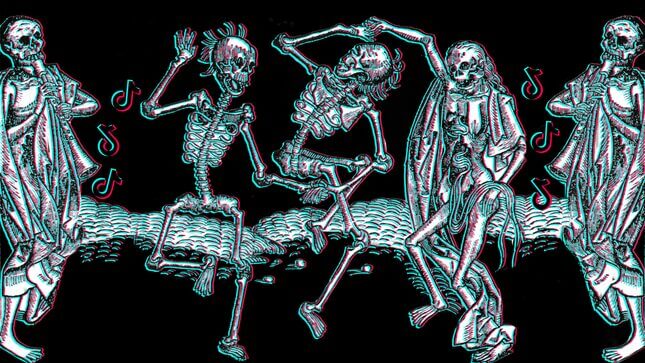
Graphic: Elena Scotti (Photos: Getty Images, AP)
It was a warm July day when Frau Troffea began to dance. She walked out of her home, into the narrow streets of Strasbourg, and began her frenzied steps. She danced uninterrupted for nearly a week, her feet swollen and bleeding. By the time she had tired of dancing, 34 of her neighbors had joined her; by the end of August, 400 of Strasbourg’s residents were dancing wildly through the streets.
It’s hard to say exactly why Frau Troffea started to dance or why her neighbors were so affected by her movements that they felt the need to join her. But one historian posits that the dance was precipitated by the psychological stresses of early 16th-century life. In 1517, the year before Frau Troffea began her dance, famine struck the town, and one contemporary chronicler simply called it “the bad year.” The bad year was a euphemism—it wasn’t just a year that was bad, it was many. Before the famine, Strasbourg had endured outbreaks of the English sweat, smallpox, and leprosy. Death loomed and disease was everywhere and nothing, not even the most fervent prayers, could stop either. Strasbourg’s institutions and its remaining citizens teetered on collapse. The residents had little to be joyful about, but they danced anyway, wild and jerking; their dancing clogged the streets, effectively paralyzing the work of the city.
Worried for the crop and capital, the city’s noblemen and burghers brought in physicians to diagnose the dancers. They determined that the dancers suffered from “hot blood,” the cure for which was simply to keep dancing. The noblemen of Strasbourg emptied the guild halls and hired musicians to accompany the dancers and lure them from the city’s narrow streets. The dance continued up a nearby mountain and at a shrine that contained the holy images of the Virgin Mary and Saint Vitus. But not even the venerated faces of the saint could fully assuage the dancers, and their twirls and pirouettes continued. Then, by the end of the summer, the dance came to an inexplicable conclusion. Some of the dancers were healed, some dropped dead from exhaustion, and others simply went home.
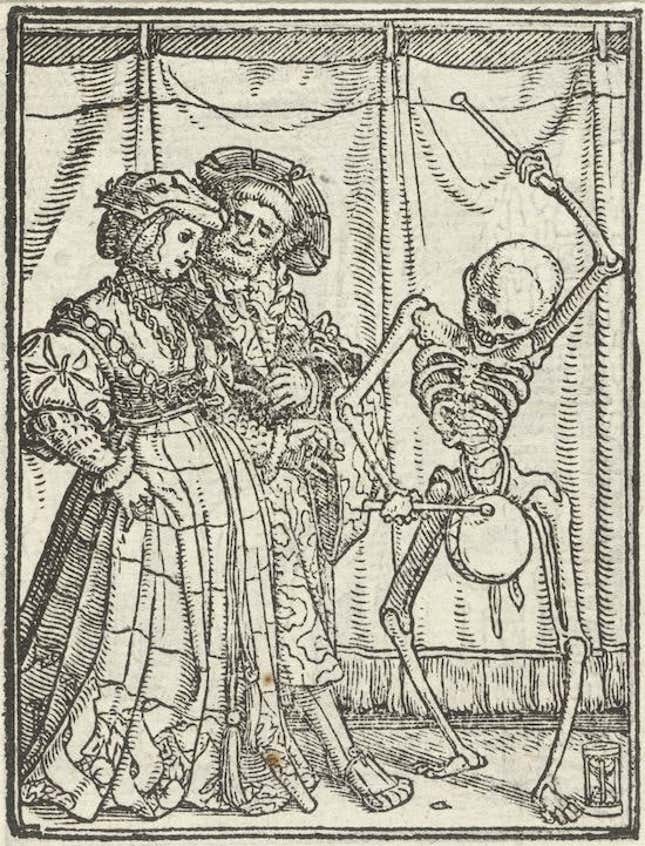
Later, the Swiss physician Paracelsus named their dance Chorea Sancti Viti or St. Vitus Dance—chorea from the Greek “to dance in unison” and Saint Vitus, a martyred boy who cleaved to God as he was being boiled in a vat of oil by debauched Romans in the early second century. Vitus himself wasn’t much of a dancer, but on his feast day, worshippers danced before his statue. It was enough to cement the association between dance and the saint. Paracelsus believed that the dancers of Strasbourg were moved by “sympathy” and “imagination.” He attributed their dance primarily to melancholy and did not think those caught in the dance hysterical or mad. Rather, in keeping with his theory of movement, he believed simply that St. Vitus dance appeared “after a shock sometimes.”
The dance, he argued, was natural, like an earthquake—movement that needed to be expressed and could not be stopped, not some kind of divine punishment. It was only much later, after Saint Vitus became associated with the tics of the female hysteric, that Frau Troffea (who Paracelsus had a low opinion of, as he did with most women) was labeled as patient zero in an outbreak of dance mania, an episode of mass hysteria. But even as the dancers of Strasbourg were inevitably and retroactively transformed into an oddity of history and a morality tale about the “inexorable collapse of morals and manners,” the melancholy of the “bad year” that moved them was unshakable. Now it’s believed such actions are the result of a kind of radical empathy—a resistance of deadening affect in the face of such feeling.
Frau Troffea haunts me now. I think about the shape of “bad year” that so affected her that it pushed her into Strasbourg’s streets for weeks and about Frau Troffea’s neighbors, who were so moved by her dance that they too transgressed bodily order, abandoning their homes and mimicking her fitful choreography. It must have seemed to them, as the theater historian Kélina Gotman wrote, “that the world was coming to an end.”

I thought about her and her troupe as I watched Sarah Palin dance to “Baby Got Back” in half of a fuzzy, neon bear costume and again when I watched a young woman “rave” to the electronic beat of the BBC News’s theme music from inside the confines of her kitchen. I thought about her as I distractedly scrolled through an article titled “10 TikTok Dances to Learn at Home,” an inventory of short dances performed with identical precision by impossibly dewy teens. They repeat their movements on an infinite loop, pretending to rock a baby or pointing to an invisible watch on their wrist. They seem stuck in a forever dance, incapable of escaping the visual confines of a smartphone screen. I thought about Frau Troffea when I watched a young man dance to Dua Lipa’s “Don’t Start Now” while (supposedly) waiting for a coronavirus test, a tissue-thin mask obscuring his face. As his dance made its way across the internet, commenters decided that it was representative of an entire generation.
It’s dancing, too, that is the source of recent controversy—not real controversy, but the kind born of the obtuse outrage that fills social media. Hospital staffs have filmed themselves dancing and posted their short routines to TikTok. These hastily performed dances are, apparently, worthy of sustained indignation, proof to conservative commenters that this bad year is simply fiction, conjured up by a media intent on destroying both country and president. Hysteria lurks in these dances, proof that stories of overworked hospitals staffs are exaggerations, if not complete lies. Devastation and dance are not supposed to partner, according to this critique. Melancholy’s expression and leisure time are supposedly irreconcilable.
But dancing and disease have always been fused. Before Strasbourg was overtaken by dance, the German physician Johann Schenck von Grafenberg wrote in his observational collection Medical Observations (1584) that St. Vitus Dance was an “enthusiasm,” that reappeared throughout Europe. It was, according to Schneck, an “amazing kind of madness that has corrupted many of our ancestors.” Schneck was referring to an outbreak of dance mania in the 1370s retroactively described as St. Vitus Dance, centuries before Frau Troffea and her 400 partners began their dance. Like their 16th century counterparts, they were moved by a deep melancholy born of uncertainty and stress. As Gotman points out, the 1370s were a decade of devastating floods: water spilled over Cologne’s city gates, flooding churches and homes. As its citizens navigated their city with boats, they watched, according to one surviving report, as their horses drowned in the streets. Surely, as they paddled through the city’s soaking remnants, many of them were struck by memories of the Black Death that had crept through Europe only decades prior.
To again witness such devastation must have felt catastrophically surreal. Perhaps they turned to dance because its expression was familiar, perhaps even comforting. As the “grand’mort” overtook Europe, people danced. In Paris, the early 20th-century historian Pierre Champion wrote that people danced “and apologize[d].” “It’s to chase away Death, they say. Thus at least they may giddily forget their sorrows.” Parisians weren’t the only ones that danced. In the Great Chronicle of France, a collection of 130 manuscripts dating from the 13th to the 16th centuries, two monks traveling through the country as the plague spread were struck by an encounter with a group who danced outside the gates of their city. The men and women believed, according to the itinerate monks, that their dancing kept the plague from entering their town, keeping their remaining friends and families safe. “We have seen our neighbors die and are seeing them die day after day,” they told the monks. “But since the mortality has [not] entered our town, we are not without hope that our festive mood will not allow it to come here, and this is the reason we are dancing.”
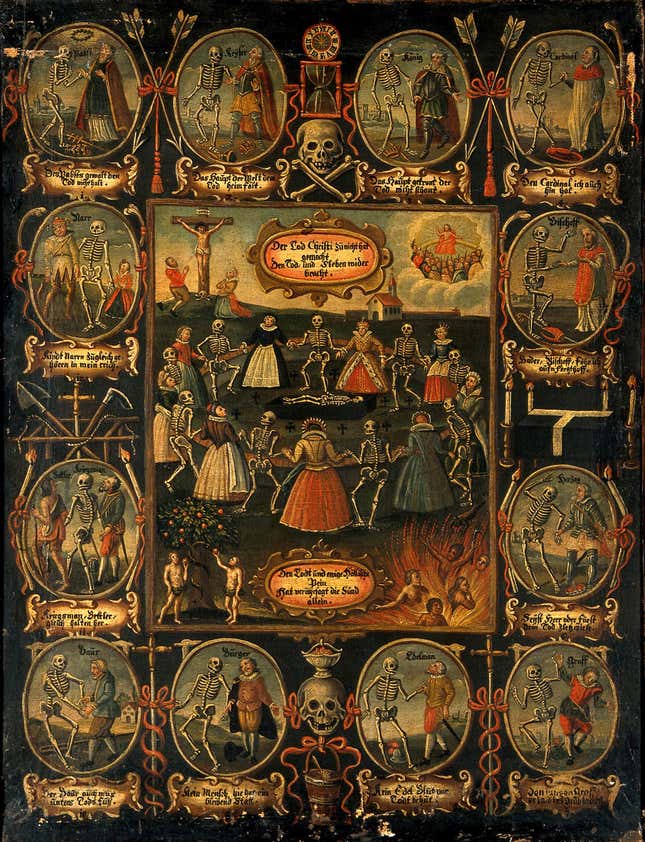
That dance had fused with the plague in the imaginations of its survivors is indisputable. Some art historians have suggested that the monks’ story—which may very well have been apocryphal—might be the origin of the Danse Macabre, an early modern visual allegory detailing the universality of death. The earliest example of the genre may have been a now-destroyed fresco gracing an arcade wall in the overpopulated Parisian cemetery, Les Saints Innocents, sometime around the early 15th century. The fresco featured a lawyer, a musician, and a scholar dancing with skeletons, a potent reminder that the Black Death was not dissuaded either by wealth or refinement. The fresco proved inspirational, and soon the Danse Macabre spread across Europe like the plague that prefaced its creation—gracing everything from grand altarpieces to illuminated manuscripts and even the more humble printed book.
Though the genre is now a relic, the dance remains, delicately threaded through grim cultural memory. Death danced through nearly every century, painted by folk artists and the fashionable 19th-century Parisian society painter James Tissot. Frau Troffea materializes in the choreographed and rehearsed march of the soldiers who spread Spanish Influenza throughout the globe in 1918 and the die-ins performed by ACT UP activists of the 1980s which were, critic David Gere suggests, a kind of choreographed dance of protest. Protestors desperate to make the AIDS epidemic sweeping through the gay community visible fell to the ground, incorporating “theatrical dance,” as the act of falling was choreographed to collapse the space between the abstract knowledge of death and its physical reality. A dire melancholy animated the die-ins, a reminder that many of those performing the actions would, in fact, fall ill and die from AIDS.
For ACT UP, the choreographed movement wasn’t simply an act of resistance to an epidemic, but movement that refused to submit to a cultural authority that demanded strict comportment. It was movement that refused to accept the moral indictment and subsequent paranoia that defined much of the public perception of AIDS. When the Archbishop of New York dismissed AIDS activists and said “good morality is good medicine,” ACT UP responded by staging a die-in in St. Patrick’s Cathedral. On a December morning in 1989, activists fell to the ground during the homily. The archbishop continued the service, ignoring the Danse Macabre reenacted before him. He refused to look at the bad year.
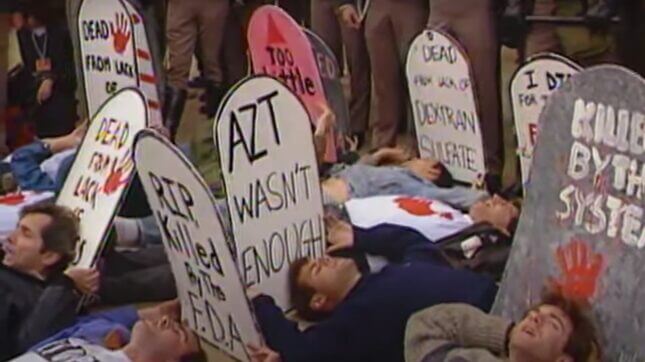
But refusing to look at the bad year or even acknowledge its existence is a practiced strategy. Even now, political and cultural leaders turn away, minimizing death and its catastrophic aftermath. Television doctors weigh the acceptable levels of mortality and elected officials treat the potential of thousands of deaths as an abstract inevitably. All of these lives are just numbers on a darkened graph chart. It’s perhaps easier to pretend that the Danse Macabre is still just an allegory and not a potent warning when Americans have retreated into their homes, emptying offices and schools and every public space. The hope of survival, the hope of health, has made us disappear off the streets. But at home, everyone seems to be dancing.
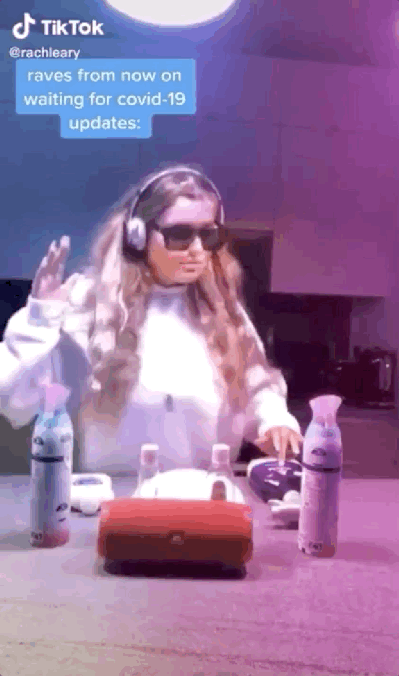
On March 24, TikTok launched the #DistanceDance challenge, aimed at encouraging people to post dances while staying at home. The platform partnered with its resident dancing queen Charli D’Amelio, a 15-year-old with more followers than anyone else, who choreographed a dance for the hashtag. Shortly after D’Amelio posted, dances filled the hashtag; one after another, users followed her choreography and mimicked her steps. For the last few weeks, they’ve danced inside their living rooms and bedrooms and backyards, seemingly unable to stop. The hashtag has nearly 5 billion views. Around the same time, families began posting group dance challenges to The Weeknd’s “Blinding Lights,” spreading the dance from individuals to whole groups who mimic each other’s movements across distances far greater than Strasbourg’s narrow streets.
Stories about these TikTok dances usually emphasize the empathy of feeling central to their creation, a brief rupture of isolation, in the most sentimental of terms. “There’s nothing like a dance challenge to bring us together,” Buzzfeed wrote. According to the Los Angeles Times, TikTok dance “during the pandemic is a form of expression and a break from the constant flow of depressing news.” There is empathy in the dances, maybe even disruption from anxiety or loneliness, but the dances are not a distraction from our bad year; they are central to its contours. Our bad year is as much TikTok dances as it is refrigerated trucks turned into makeshift morgues and convention centers, once swollen hubs of busy work and hobbyists, transformed into temporary hospitals. It is the dead piled up at a Detroit hospital and a daughter distantly dancing with her elderly parents. It is our own institutions teetering on collapse and a grey-haired dad enthusiastically being lifted into the air. It is Frau Troffea and the Danse Macabre.
In his Memoirs of the Plague in Florence, Giovanni Baldinucci described “the streets and churches without anyone in them.” He wrote with a tone of melancholy, of sadness, for these abandoned places that had once been the backdrop of such bustling physical intimacy. Florentines had been sent home. Quarantined and separated, they hid from the invisible disease. But at home, they relished what remained of that intimacy. A surviving 17th-century report recounts the story of two Florentine teenagers, Maria and Cammilla, who were arrested for dancing in their home, when the movement had been banned. “In order to pass the time we dressed our brother up in a mask, and we were dancing among ourselves,” the girls said during their trial.
Maria and Cammilla’s fates are unknown. We do not know if they survived the plague or grew into old women. Their dance is the only surviving record of the girls, just as Frau Troffea a century before them. But they are bound together by the choreography of bad years, and so are we.